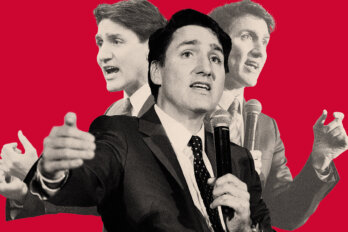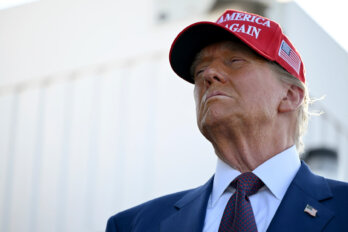In last month’s election, Justin Trudeau and the Liberal Party of Canada earned a stay of execution. But, if they want to get off political death row entirely and repeat the majority government that Justin’s father, Pierre Trudeau, earned in the wake of his own minority setback in 1972, the party will likely need to win over a few hundred thousand voters in Ontario, Quebec, and British Columbia in the next election. And the easiest way to do that could be by fulfilling the pledge that brought so many out to vote Liberal in 2015: electoral reform.
As the leader of a party that was in third place at the time, Trudeau promised that the 2015 election would be the last one contested under the first-past-the-post system. Tens of thousands of Canadians were understandably frustrated with a political system in which candidates can win office with only the highest number of votes rather than a majority, producing unsatisfactory democratic outcomes. In 2011, for example, Stephen Harper’s Conservatives won 54 percent of the seats with just under 40 percent of the popular vote. First-past-the-post also has a tendency to amplify regional grievances along with the parties that successfully exploit them, like the Bloc Québécois. Trudeau’s pitch to replace this system found a receptive audience in many parts of the country.
But Trudeau’s position on the issue shifted. And no wonder: if the 2015 election had been conducted using proportional representation—that is, assigning seats on the basis of the popular vote—the Liberals would have won 133 of the 338 seats instead of 184. That might help explain why, even after the Special Committee on Electoral Reform (on which Liberal members were a minority) issued its 2016 report recommending a switch to proportional representation, Trudeau decided to abandon his promise.
Proportional representation advocates and the parties who would benefit most directly from it, like the NDP and the Greens (who routinely win a much higher percentage of the popular vote than they do seats), were outraged. This outrage is understandable. If the 2015 election had been run using a proportional system, the NDP would have won sixty-seven seats instead of forty-four, while the Greens would have twelve instead of just one.
But, as Patrice Dutil wrote in the May 2017 issue of the Literary Review of Canada, their outrage doesn’t make them right. Proportional systems have, in fact, caused strife in countries such as Italy and Germany, which each use a variation of the voting method. That’s because the system has a habit of creating unstable governments, in large part by breeding distrust over the deal-making needed to hold those governments together. “People are not pleased to see government depend on political coalitions that, in turn, rely on small parties to stay in power,” wrote Dutil, a political-science professor at Ryerson University. “They do not like the idea that these coalitions are formed by agreements hatched in the dark.” There is no evidence, he argues, that Canadian democracy would be improved by the switch.
The public’s aversion to proportional representation has been demonstrated in a number of different Canadian referendums. In British Columbia, a system called “single transferable vote” was put to voters by the BC Liberal government in the lead up to the 2005 provincial election, and 57.7 percent of voters supported it. But that wasn’t enough to clear the “supermajority” threshold of 60 percent, and single transferable vote was put back on the ballot in 2009—when only 39 percent of voters supported it. In late 2018, the BC government (now led by the NDP) held yet another referendum, but it, too, produced a roughly 60–40 vote split in favour of the status quo. Referendums on electoral reform also failed (and by the same 60–40 split) in Prince Edward Island, in 2005, and Ontario, in 2007. After a 2016 nonbinding plebiscite in PEI, electoral reform squeaked out the tiniest of victories; three years later, 51.7 percent of islanders voted against changing first-past-the-post.
True, a national referendum on the issue isn’t necessarily doomed to fail. A recent Angus Reid Institute poll showed a major increase in support for electoral reform, with 68 percent of Canadians now open to the idea compared to 53 percent in January 2016. And the biggest lift in support came from Conservative supporters, who saw their party win the most votes in the recent election but fail to form government. But, after the petty scandals and toxic partisanship that defined the recent election (where even the sainted Greens hired self-described “Prince of Darkness” strategist Warren Kinsella to help set up a “situation” room to protect party leader Elizabeth May), does anyone really want to implement a system where the smallest group of angry and disaffected voters can end up tipping the parliamentary scales?
That’s why it’s time to replace our electoral system with one that empowers voters, builds consensus, and punishes those who are deliberately polarizing. The best way to do that is by implementing a ranked ballot.
A ranked ballot (also known as “instant runoff voting” or “ranked choice voting”) allows voters to rank their preferences rather than selecting just one. Unlike a first-past-the-post candidate, a ranked-ballot candidate must get more than 50 percent of the vote to win. If nobody reaches that threshold, the worst-performing candidate is eliminated and their votes are redistributed to each voter’s second choice. This process continues, round by round, until the 50 percent threshold is crossed.
Australia’s lower house and Ireland’s legislature already use a form of ranked ballot to elect their representatives, while cities like San Francisco, Minneapolis, and Portland use it at the civic level. In 2018, Maine became the first state to use ranked ballots, and 73.5 percent of New Yorkers just voted to implement a ranked ballot for municipal elections state-wide. In Canada, London, Ontario, became the first municipality to use a ranked ballot last November. Ed Holder, a former Conservative MP, was named the new mayor from a field of fourteen candidates. It took almost eighteen hours and fourteen rounds of counting to reach the threshold of 48,320 votes needed to win. Dave Meslin, a long-time electoral reform advocate and the author of Teardown: Rebuilding Democracy from the Ground Up, described the process, in Maclean’s, as “the first fair election I’ve seen on Canadian soil in my lifetime.”
With good reason: for the first time, voters could express their full democratic preferences rather than being boxed into voting for some least-worst option. By replacing the familiar frustration of strategic voting with what Laval University political-science professor Jean-Pierre Derriennic has called “sincere voting,” ranked ballots could help insulate our democracy against the growing threat of political polarization. That’s because ranked ballots don’t reward politicians who play to a limited portion of the electorate if those efforts alienate a given party from the rest of the voters. Ranked ballots also discourage negative campaigning, which effectively involves burning the bridges you should be building to supporters of other parties. Twenty-one American cities used the system in their local elections in 2013 and 2014. Surveys conducted by electoral reform advocacy group FairVote revealed that likely voters in those cities “were more satisfied with the conduct of candidate campaigns, and perceived less candidate criticism and negative campaigning.”
Ranked ballots wouldn’t replace the winner-take-all nature of our current system, and in some cases, Derriennic argues, they could actually produce even stronger parliamentary majorities. But, as he wrote in a 2016 essay for the Canadian Parliamentary Review, those majorities are more authentic than the ones produced in a first-past-the-post system. And, where proportional representation can encourage the creation of single-issue parties, ranked ballots reward moderation and consensus building. They would also dampen the influence of regional-grievance-based parties like the Bloc Québécois—and any western separation party that might arise in Alberta and Saskatchewan. “This added bonus of moderation is desirable in a democracy,” Derriennic says, “because it incites political parties to avoid the simplistic arguments that emphasize the differences between them.”
As it happens, that’s why Justin Trudeau has supported the idea of ranked ballots since he ran for leadership of the Liberal Party. This shouldn’t be too surprising: a system that rewards moderation and temperance—values Liberals have tried to trade on for decades with varying degrees of success—might tilt the electoral table in Trudeau’s direction. Still, his concerns about proportional representation aren’t entirely partisan. “I think it would weaken one of the great things about Canada, which is that we come together in our diversity to work together on big things,” he said in 2017. “And I think creating fragmentation amongst political parties, as opposed to having larger political parties that include Canada’s diversity within them, would weaken our country.” Those comments echo the ones he made in 2013, when he noted that “too many people don’t understand the polarization and the microissues that come through proportional representation.”
This built-in inclination toward compromise rather than conflict could even contribute to a better relationship with Indigenous peoples in Canada, as James Arreak, then CEO of Nunavut Tunngavik Inc., suggested in his comments to the Special Committee on Electoral Reform in December 2016. “In a first-past-the-post contest, a person can be elected having extreme positions that may appeal to a minority of voters but that are heartily rejected by a majority,” he said. “The ranked-candidate system appears to be more in keeping with the premium placed on consensus building and the preference for inclusiveness that is characteristic of Inuit culture.”
The impact that a ranked ballot can have on representational diversity is just as encouraging as its moderating influence on the way representatives campaign and govern. American scholars studying the impact of ranked ballots at the local level have found that they increase the share of racial-minority candidates, female candidates, and female minority candidates. And it’s not just that these traditionally underrepresented candidates tend to run more often in cities with ranked ballots: according to a growing body of evidence, they win more too. In London, Ontario, for example, the first openly gay councillor and the first Black female councillor were both elected in 2018.
Ranked ballots could even help prevent the emergence of leaders like Donald Trump since they reward the breadth of a politician’s support instead of its intensity. As Andrew McGill wrote, for The Atlantic, back in early 2016, “Trump keeps winning, with an ardent fan base that has handed him plurality after plurality in primary states—though rarely a majority. It’s the unified few versus the dispirited many.” And, while some Conservatives aren’t exactly thrilled with Andrew Scheer’s recent performance, they’re surely glad that the ranked ballot they used at their 2017 leadership convention picked him over Maxime Bernier. Republicans may find themselves wishing they’d used one too.
That’s why Justin Trudeau should push ahead with the implementation of ranked ballots at the federal level. His desire, stated in 2016, not to impose his own preference on the electoral reform process is understandable, but it hasn’t served either his party or his country particularly well. And, while a ranked ballot wouldn’t address all of the concerns expressed by Canada’s small but vocal electoral reform movement, it would substantially improve millions of Canadians’ experiences of voting. It would help draw us all back toward a more productive and civilized conversation. It would give more people a reason to vote, and it would support higher levels of political participation for women and minorities. Most importantly, it would offer protection from the tide of populism and illiberalism swamping democracies around the world—one from which not even Canada is safe.





